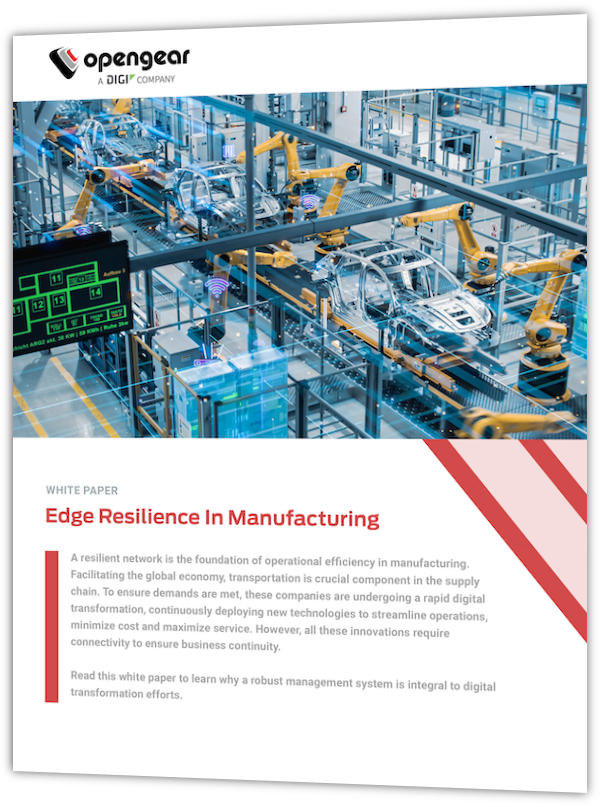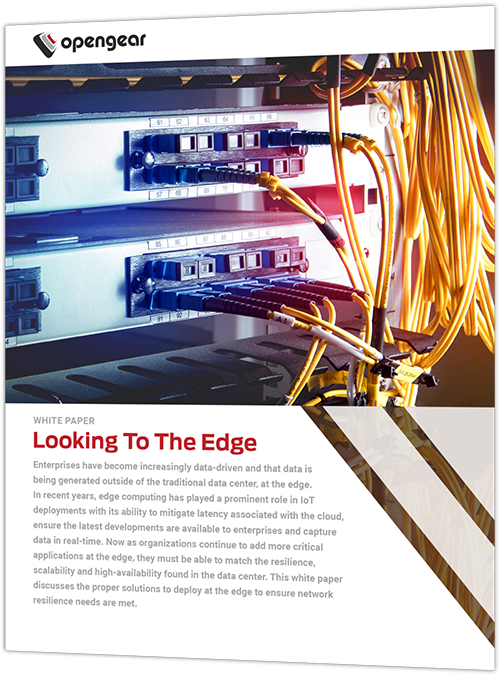Optimizing Operational Efficiency
Fueled by digital transformation, the manufacturing industry has entered into the 4th Industrial Revolution. Automation, the Internet of Things (IoT) and 5G are a few technologies being deployed that require a resilient network to efficiently operate.
Limited IT resources and the distributed nature of manufacturing create additional challenges with infrastructure management. Multiple factories operating with high degrees of autonomy, a variety of technology stacks and myriad of production lines make it difficult to scale local deployments across an organization.
Opengear’s solutions have been deployed by some of the largest manufacturing companies in the world. Easily managed, scalable and providing the network resilience needed for business continuity, organizations have full visibility of their network.
Learn more about building a resilient manufacturing network by downloading our white paper.

Enabling Maximum Uptime
Manufacturing companies are leveraging digital transformation initiatives to enhance productivity, increase efficiency and optimize costs. Considered Smart Manufacturing, these fully integrated, collaborative manufacturing systems respond in real-time to meet changing conditions in the factory, in the supply network and in customer needs. The addition of new technologies provides a wide range of new capabilities however, they also place additional strain on the network, increasing the chance of a disruption.
To successfully implement these new technologies, manufacturers must simplify network management and ensure connectivity with an always-on, independent management plane.
Get more information on enabling uptime at distributed sites with our overview sheet.
Advancing Operations
Downtime costs manufacturers approximately $50 billion per year. There’s a myriad of challenges when it comes to network infrastructure in manufacturing that can disrupt operations, such as:
Legacy Equipment: The advancement in automated and connected technologies, has made managing new and old equipment simultaneously difficult, it’s common for industrial facilities to contain both new, digitalized and legacy equipment that has not been designed with connectivity in mind. As businesses expand, it’s also common for them to acquire new locations, creating a mix of old and new sites can add even more complexity, making it challenging to streamline each piece of equipment.
Factory Visibility: Traditionally, data centers had engineers present to actively monitor infrastructure. However, as these enterprises evolve, real-time monitoring is lacking and network complexity has grown as factories become more interconnected. Housing thousands of end points and devices that are constantly collecting data, these facilities require full visibility and remote management capabilities to reduce any disruptions to operations.
Downtime effects many aspects of a manufacturing facility. From decreased productivity and compromised staff safety to damaged equipment and unturned inventory are just a few consequences of not building a resilient network.
Security: Facilities collect large amounts of highly sensitive data. Strict guidelines have been put in place to ensure these insights are protected where non-compliance can result with major breaches, fines and loss of revenue. As cybercrime rises, security has become an even larger concern for organizations.
To ensure maximum uptime, manufacturers need a comprehensive solution designed to provide the highest levels of business continuity through proactive monitoring and remediation. Factories have the ability to simply and securely deploy new remote sites as needed.
Watch our use case video to learn why constant connectivity is critical in this industry.
Ensuring Network Resilience
Redundancy is an important with manufacturing infrastructure, and the reliability of a data center relies heavily on back-up generators, on-hand replacement hardware and secondary network connections. Redundancy is a part of the resilience solution, but not the only consideration. In smaller locations and satellite offices, it’s not cost-effective to build in redundancy. Not having technical staff on-site, the ability to monitor, manage and remediate the IT infrastructure remotely is a significant addition to a resilient solution.
Smart Out-of-Band management allows the network engineering team to securely access critical devices from a central location, to anticipate and remediate issues without sending a tech to site.
The Network Resilience Platform is based on the presence and proximity of an Opengear Console Server at every IT location, centrally orchestrated through Lighthouse Management Software. It provides secure remote access to your critical network devices through a separate management plane.
Explore how Opengear provides secure access on Day One, every day, and during an outage.
Demo Video
Watch our demo video to see an in-depth overview of the capabilities of the Opengear console server Web UI.

